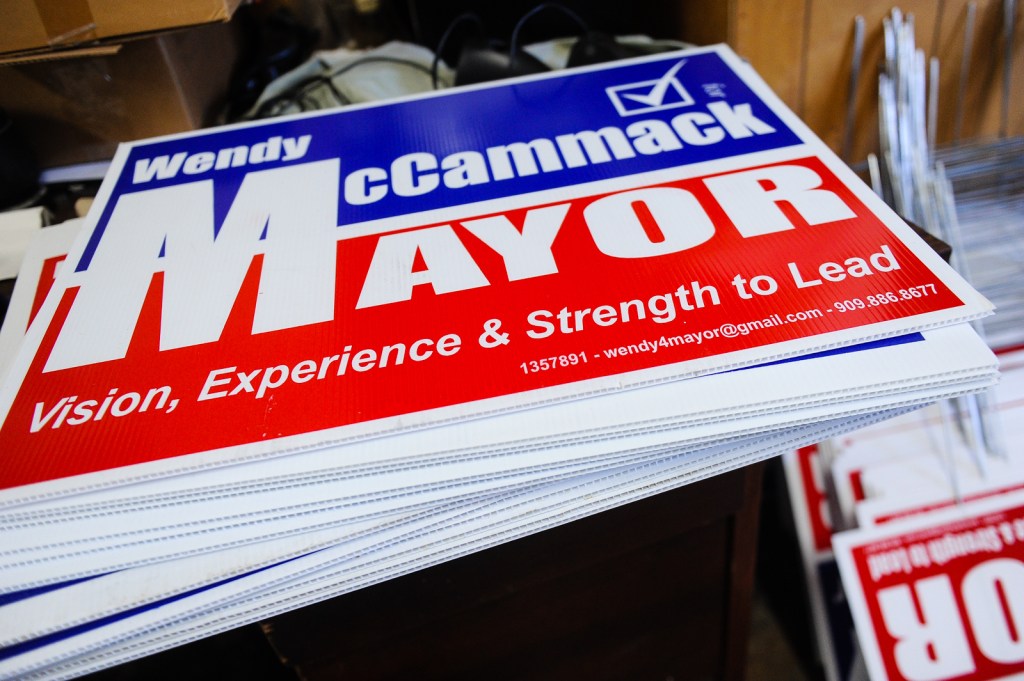Most Inland Empire cities that pass their own campaign finance laws want to keep campaign spending under California’s current cap of $5,500 for local candidates.
But a few go the other way, choosing to open the floodgates for spending.
And one local city has gone back and forth on the issue.
A new report from the nonprofit Common Cause California includes data from the 180 California cities that have imposed local campaign finance restrictions. Common Cause seeks to “create open, honest, and accountable government that serves the public interest; promote equal rights, opportunity, and representation for all; and empower all people to make their voices heard in the political process,” according to its website.
“There’s at least some intangible impacts on community trust” in local politicians who follow tighter rules for local elections, according to Marcia Godwin, a professor of public administration at University of La Verne.
A little less than one-quarter of California’s 483 cities have passed local campaign finance laws that effectively replace the state’s limits under Assembly Bill 571, which went into effect on Jan. 1, 2021. On average, in 2024, the 123 California cities that established their own rules cap campaign contributions at an average of $777 per candidate, less than one-seventh of the state’s current contribution limit of $5,500.
“California has long been a trailblazer in campaign finance reform, implementing regulations to curb the negative effects of big money on the local level, but there is still work to be done,” Sean McMorris, transparency, ethics, and accountability program manager for California Common Cause, is quoted as saying in a news release announcing the nonprofit’s Jan. 30 report. “As our report shows, cities can implement impactful reforms that build on and improve existing state laws.”
The group’s updated California Municipal Campaign Finance Index (a downloadable Excel spreadsheet) summarizes campaign finance laws in every California city that has local rules in effect.
Sometimes, local governments decide the state’s campaign finance laws are too restrictive, and either raise or even completely scrap contribution limits.
Critics contend that eliminating those limits benefits some of the biggest donors in California politics: real estate developers and unions, Godwin said.
Those governments loosening the reins or removing all restrictions on political spending are rare, though.
“I think that the vast majority that have adopted lower limits as opposed to higher limits shows some local political support” for lower levels of spending on political campaigns, Godwin said.
Local limits
 In the Inland Empire, about a dozen cities have passed their own campaign finance rules. Some have passed rules that are more strict than those in AB 571. Some are less strict. Some have what amount to placeholders that say local candidates should follow state law. And some just tweak other areas of campaign rules.
In the Inland Empire, about a dozen cities have passed their own campaign finance rules. Some have passed rules that are more strict than those in AB 571. Some are less strict. Some have what amount to placeholders that say local candidates should follow state law. And some just tweak other areas of campaign rules.
San Bernardino and Victorville have established new rules that essentially require candidates to follow state law, or which tweak other elements of campaign governance, similar to Rancho Cucamonga’s creation of an electronic filing system for financial documents, which goes above and beyond the requirements of AB 571.
Several Inland Empire cities have embraced lower spending caps than the state’s default limit of $5,500 per donor to city council candidates:
Other cities have gone the opposite way, allowing more money into politics than the state allows:
Perris changes direction
And then there’s Perris.
In 2022, the Perris City Council voted to allow donors to be able to give up to $21,500 to council candidates.
But this January, the council pumped the brakes.
“A resident here could write me a check for $20,000,” Councilmember Malcolm Corona said at the council’s Jan. 28 meeting. “But no resident of Perris ever donated $20,000. We know who donates $20,000: People from outside the county would.”
Corona said the council’s 2022 decision on campaign finances “made him sick to his stomach.”
“We knew what would happen and it happened,” he said in January, referring to a large influx of large out-of-town donations in the following elections.
According to Perris’ campaign finance portal website, during the 2024 election cycle, the Riverside-based Inland Empire Taxpayers Association political action committee made two $20,000 donations to candidates’ campaigns. The first was to incumbent Councilmember Rita Rogers, who lost the District 2 race to Elizabeth Vallejo.
Meanwhile, Vallejo’s campaign raised a total of $14,000 from a variety of donors. The largest contributors to her campaign were Assemblymember Corey Jackson, D-Perris, who donated $5,000; Vallejo herself, in the form of a $4,632 loan; and Councilmember Corona, who donated $2,000.
The IETA also donated $20,000 to Mayor Michael Vargas, who won reelection in November. Vargas also received a $14,900 donation from Santa Monica-based truck stop developer Babak Nassirzadeh.
Mayoral candidate Lupe Gomez received a $7,500 donation from the Sacramento-based California Grocers Association.
For now, donations of that size won’t be part of Perris’ 2026 election cycle. The City Council voted 3-2 on Jan. 28 to impose a campaign donation limit of $2,500 — less than half of what California law sets as the default limit.
Vargas and Councilmember David Starr Rabb voted against the change.
Originally Published:



